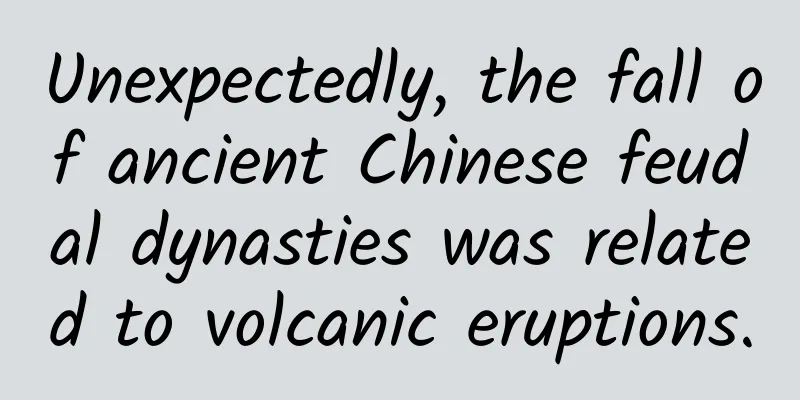Unexpectedly, the fall of ancient Chinese feudal dynasties was related to volcanic eruptions.

|
What do we think of when we think of volcanic eruptions? The spectacular mushroom cloud? The rolling lava? The majesty of nature? Or the extinction of dinosaurs? Few people would associate volcanic eruptions with the fall of ancient Chinese dynasties, right? Recently, researchers from the School of Environment and the Department of Biological Sciences at Rutgers University in New Jersey, USA, analyzed the sulfate content in Greenland and Antarctic ice cores, reconstructed 156 volcanic eruptions between 1 AD and 1915, and analyzed the historical changes of 68 dynasties in ancient China. They confirmed for the first time that in the past 2,000 years, the collapse of ancient Chinese dynasties was more likely to occur a few years after a volcanic eruption. In other words, volcanic eruptions often lead to the demise of ancient Chinese dynasties. "We have shown for the first time that the collapse of dynasties in China over the past 2,000 years is closely linked to volcanic eruptions," said Alan Robock, a co-author of the study and a distinguished professor in the School of the Environment and the Department of Biological Sciences at Rutgers University. "But this relationship is complicated because the collapse of dynasties was primarily a direct result of ongoing warfare and conflict, while climate change caused by volcanic eruptions could have affected crop yields, further exacerbating the collapse of dynasties ." The related research was published in the latest issue of Communications Earth & Environment magazine under the title “Volcanic climate impacts can act as ultimate and proximate causes of Chinese dynastic collapse”. The impact of volcanic eruptions on humans is far beyond our imagination Speaking of volcanic eruptions, many people may not be unfamiliar with them. We have more or less seen scenes of volcanic eruptions on TV, news or other media platforms. Of course, since most volcanic eruptions are currently within the known range of human beings, few people are afraid of volcanic eruptions. Only when they hear about the extinction of dinosaurs or the ancient city of Pompeii will they imagine the violent scenes of large-scale volcanic eruptions. Therefore, in the eyes of most people, unless it is a very large-scale volcanic eruption, it has almost no impact on human life activities. (Source: Pixabay) However, in the 1970s-1990s, a seemingly insignificant and mild volcanic eruption eventually caused the deaths of 250,000 people and turned 10 million people into refugees. This was the famous Sahel drought. Sahel mainly refers to the tropical savannah area south of the Sahara Desert in Africa, including Mali, Senegal, Chad, Ethiopia, Sudan, Somalia and other countries and regions. It is attacked by the dry and hot winds of the Sahara Desert all year round. The Sahel tropical savannah is gradually becoming desertified and has become a high-incidence drought area in the world. In the early 1970s, the Sahel region suffered from a five-year drought, during which there was almost no rain in some years. In 1982, Africa was hit by drought again, and the countries in the Sahel region were once again the first to bear the brunt of this disaster. The Niger River Basin in Mali is an important grain-producing area. Every year, a large amount of fertile silt from the Niger River is deposited here. But in 1982, people looked forward to the heavy rain, but they never saw it. In previous years, the rice planting area in Tenangu was often more than 4,600 hectares, but the next year, this famous rice-producing area only planted 90 hectares. In other parts of Mali, both in the north and the south, the rainfall was half of that in normal years. (Source: RUTGERS UNIVERSITY-NEW BRUNSWICK) Senegal was also hit by the drought, with sorghum and millet production falling by half compared to previous years. Peanuts, the main crop in the north and central parts of the country, were almost completely withered, and in the Sin-Saljuan region, which accounts for 70% of the country's peanut production, peanut production also fell by nearly half. Even though the Food and Agriculture Organization of the United Nations urgently appealed to the international community to provide 3.2 million tons of food aid in 1983-1984, by 1985 the international community had provided Africa with tens of millions of tons of food, large amounts of medicine, clothing, tents and other urgently needed items. However, in the end, the drought still caused the deaths of hundreds of thousands of people and tens of millions of people became victims. So, what does this disaster of the century have to do with the volcanic eruption? Generally speaking, large-scale volcanic eruptions will form sulfide clouds in the sky, blocking sunlight for about 1-2 years, thereby lowering the temperature of the earth's surface and causing the monsoon to weaken and rainfall to decrease. In the process of analyzing the causes of the Sahel drought in the 1980s, people found through global climate model simulation that large-scale volcanic eruptions will significantly reduce precipitation in tropical regions 1-2 years after eruption. Although the El Chichón volcano eruption in Mexico in 1982 was relatively mild, it may still be closely related to the drought in the Sahel region of Africa. How volcanic eruptions influenced the fall of ancient Chinese dynasties From a historical perspective, there are three main reasons for the demise of ancient Chinese dynasties . First, the internal system of the country was rotten, officials were corrupt, and the country was suffering from serious internal friction. Second, there were powerful external enemies, the ethnic minorities grew stronger, and united to overthrow the rule of the feudal dynasty. Third, there was internal rebellion, the core of domestic power coveted the throne and overthrew the existing dynasty. Among them, the decay of the internal system of the country is also the main reason for the collapse of the ancient Chinese dynasties. Looking at the entire ancient Chinese dynasties, most of them have a general rule, that is, in the early stage, the politics is clear, the country is recuperating, and the people are strong; in the middle stage, the monarch is incompetent, the officials are corrupt, the relatives of the emperor and the court interfere in politics, and the land annexation is serious; in the later stage, foreign invasions, people's uprisings, eunuchs' monopoly of power, and local separatism eventually lead to the collapse of the country. Obviously, when talking about the reasons for the replacement and fall of dynasties in ancient China, few people would think of volcanic eruptions. (Source: Pixabay) Previously, when people studied the impact of volcanic eruptions on the global climate, they found that volcanic eruptions can pump millions of tons of sulfur dioxide into the atmosphere, forming huge sulfuric acid clouds that reflect sunlight and lower the temperature of the earth's surface. At the same time, the study also found that global climate change caused by large-scale volcanic eruptions has a huge impact on crops, and may cause many crops to face the dual dangers of cold and dryness during the growing season. In addition, climate change will lead to a series of problems such as livestock deaths, accelerated land degradation, warmer winters, and the breeding of crop pests, further aggravating crop damage. (Source: Pixabay) Studies have shown that when a society's political and economic stress is already high, a smaller volcanic eruption's "shock" to the climate can lead to social collapse and the fall of a dynasty, while a larger volcanic eruption can destroy a dynasty without a significant increase in social stress. Therefore, after analyzing the sulfate content in Greenland and Antarctic ice cores, the researchers reconstructed data on 156 volcanic eruptions between 1 AD and 1915 and found that compared with volcanic eruptions in humans in the 20th and 21st centuries, volcanic eruptions during China's ancient feudal dynasties were significantly larger in scale. At the same time, after combining the analysis of the historical changes of 68 dynasties in ancient China and thousands of wars between 850 and 1911 AD, the researchers finally confirmed that the collapse of ancient Chinese dynasties mostly occurred a few years after volcanic eruptions due to the impact of volcanic eruptions on the environment and crops. The results of this study mean that future volcanic eruptions, along with climate change, could cause severe disasters in more populated marginalized areas of the Earth. Therefore, we need to prepare for future volcanic eruptions, especially in centuries and regions with vulnerable populations and economies. References: https://www.nature.com/articles/s43247-021-00284-7 https://www.rutgers.edu/news/volcanic-eruptions-contributed-collapse-china-dynasties Written by: Zhu Hengheng Editor: Wang Xinkai Typesetting: HS |
<<: How to become the most beautiful crab in the sea? Sea anemone: I will help you with your styling
>>: The past and present life of a piece of tea - Tea Horse Road
Recommend
@2022 College Entrance Examination, please accept this college entrance examination tips
The 2022 National College Entrance Examination is...
The “common face” of the “super shield”: Why do the return capsules of spacecraft look similar?
Every time you see the spacecraft's return ca...
What is the relationship between Qiantang River and Zhejiang?
Qiantang River is famous for its tidal wonders kn...
It's as smooth as iOS and as stable as Android, so why doesn't anyone use it?
Among the world's three major mobile operatin...
Guang'an Mini Program Agency Company, how much does it cost to be an agent for a flower mini program?
How much does it cost to be an agent of Guang'...
How much does it cost to develop a Gannan shoes and boots mini program?
How much does it cost to attract investment throu...
You can lower your blood pressure without dieting. Check out this high blood pressure diet guide
Contributed by "Panda Medical Cartoons"...
Stinky car is trending on the Internet, the smell is like getting into the driver's bed! Where does the stinky car smell come from?
At the end of the year, there is one more reason ...
CES 2015 mobile phone product preview: many flagships will be released
The US International Consumer Electronics Show (C...
Hupu APP Product Analysis Report
This article conducts product experience and anal...
A guide to setting up a GuangDianTong information flow account!
How to choose from so many slots? How can we achi...
Tencent Advertising advertiser account opening qualification requirements!
Enterprise account opening qualification requirem...
Owl: I am a “round owl”, not a “Yuanxiao”!
As we all know, the symbol of the Lantern Festiva...
Can you use hot water to pour hot water on frozen car windows in winter? | Car "rumor" crusher
Nowadays, cars play an indispensable role in our ...
A must-know method for user growth: retention curve
The editor’s previous article "Growth Strate...









